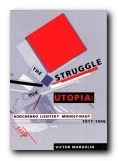re-thinking the way we make things
Cradle to Cradle is the programme for a philosophy of ecological design principles based on a consciousness of the global environment. IT raises fundamental issues about sustainability, well-used resources, and sensitivity to eco-systems. The authors are an architect and a chemist who between them tackle issues from major construction projects, to the design of shampoo and re-cyclable running shoes. It’s a work whose primary purpose it to make you think about design issues. Don’t expect glamorous colour photographs or examples of slick kettles and toasters – but be prepared to have your notions of ‘waste’ and ‘re-usability’ challenged in a radical manner.
 Their stated aim is to re-think the way in which everything is made. And though they posit a very radical philosophy of using design intelligently, they are not reactionary when it comes to modern industry. In fact the book starts with an account of the Industrial Revolution which focuses on many of its good intentions – before listing its contemporary weaknesses in terms of the world’s ecology. They make their case for eco-consciousness using the very book itself:
Their stated aim is to re-think the way in which everything is made. And though they posit a very radical philosophy of using design intelligently, they are not reactionary when it comes to modern industry. In fact the book starts with an account of the Industrial Revolution which focuses on many of its good intentions – before listing its contemporary weaknesses in terms of the world’s ecology. They make their case for eco-consciousness using the very book itself:
It is printed on a synthetic ‘paper’…made from plastic resins and inorganic fillers. This material is not only waterproof, entirely durable, and (in many localities) recyclable by conventional means; it is also a prototype for the book as a technical nutrient’, that is, as a product that can be broken down and circulated indefinitely in industrial cycles – made and remade as ‘paper’ or other products
Good you might think: but the book is surprisingly heavy, and (though most people don’t know this) the biggest part of the cost of getting printed books to the public is transportation costs, based on weight.
They are also critical of what they see as shortsighted attempts to solve ecological waste by recycling:
your [recycled] rug is made of things that were never designed with this further use in mind, and wrestling them into this form has required as much energy – and generated as much waste – as producing a new carpet
The solution often proposed for these problems is called eco-efficiency – ‘doing more with less’. But they suggest that this just gives the appearance of social concern without changing the basic systems of industrial production. As they put it, ‘Being ‘less bad’ is not good: it is to accept things as they are.’
Examining the relationship of human beings to the planet at a very fundamental level, they come up with an interesting concept – that there is really no such thing as ‘waste’. Because when we throw things away, they do not go away. Indeed there is and can be no ‘away’. These things stay with us even if they are dumped in landfills, and even if they are incinerated we are still left with the by-products of combustion (including the CO2).
There is no need for shampoo bottles, toothpaste tubes, yogurt and ice-cream cartons, juice-containers, and other such packaging to last decades (or even centuries) longer than what came inside them
Some of the ideas they propose as alternatives seem rather fanciful. Recyclable televisions for instance: could their internal parts really be cost-effectively extracted and re-used? Running shoes with replaceable soles? But they do claim to have had a success with an upholstery fabric which is bio-degradable.
They are very much in favour of using local materials (think how wasteful it is transporting them from afar) and encouraging the use of local labour, which promotes the local economy.
It’s a book crying out for graphic illustration – particularly when they come to describing the ecologically positive buildings they have designed – with grass-carpeted roofs and tree-lined interiors. Nevertheless, I think this may well be one of those modern design classics which will find its way alongside Donald Norman’s The Design of Everyday Things and Viktor Papanek’s Design for the Real World as a standard text on every design curriculum.
© Roy Johnson 2002
William McDonough and Michael Braumgart, Cradle to Cradle, New York: North Point Press, 2002, pp.193, ISBN: 0099535475
More on design
More on media
More on web design
More on information design

